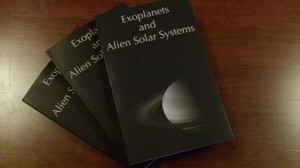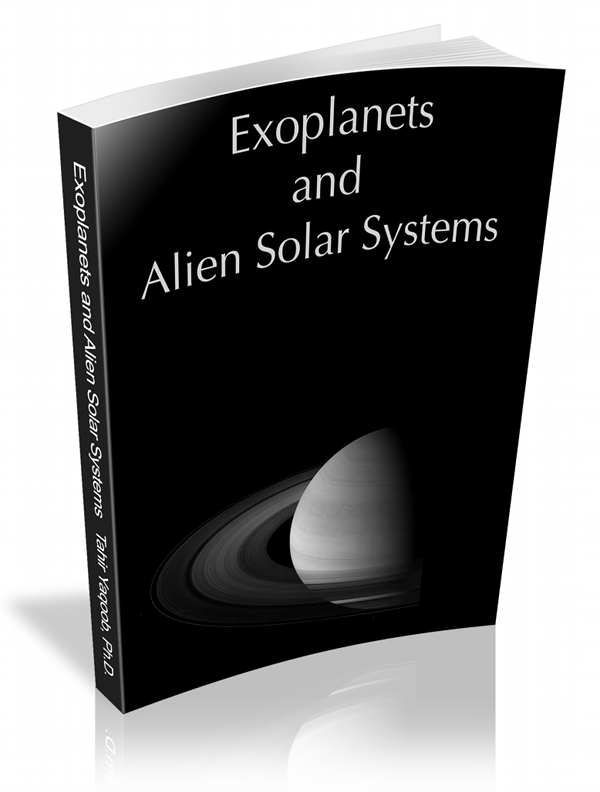Extrasolar Planets Book and eBook: Exoplanets and Alien Solar Systems
Exoplanets and Alien Solar Systems
by astrophysicist Tahir Yaqoob, Ph.D.
Available in Paperback and eBook Formats
Exoplanets and Alien Solar Systems has been in the top 10 in the category of Astrophysics and Space Science, reaching number 3 in that category in early 2012, above Carl Sagan’s Pale Blue Dot, and below only The Grand Design (by Stephen Hawking) and Packing for Mars.
“The author’s approach to each subject indicates a savvy for the teaching process. The material is well organized into sections and the book overall is not tedious on the eye, in fact at times I didn’t want to put it down.”
— Dave Reneke, writer for Australasian Science magazine. Read full review.

Unlike other books concerning extrasolar planets, Exoplanets and Alien Solar Systems faces difficult issues raised by the many recent unexpected discoveries, head on. In particular, it explains why the current theories of planet formation and migration are spectacular failures. For example, recent observations of systems like Kepler-20 in which apparently rocky planets live side-by-side with gas giants cannot be understood in the framework of current theories. A new line of investigation is described which resolves the conflicts and involves planet creation from mass ejections from the host star. The book explores the things that we don’t understand, as much as those that we do understand. It also equips the reader to understand, correctly interpret, and place into context, news stories in popular media. Although unexpected new results are impossible to anticipate, especially in such a rapidly advancing field, the foundations presented in the book, combined with selected online resources, give the book a robustness that will not make it quickly outdated.
Synopsis
There is a quiet revolution going on. An unprecedented number of planets outside of our solar system (exoplanets, or extrasolar planets) have been found, with an explosion in the number of discoveries in recent years. The collective human consciousness has arrived at a place that was inaccessible not long ago. Once upon a time, humanity had not even conceived questions such as, “Are there planets beyond our solar system?” or “Is there intelligent life on other planets?” Find out what has been happening in this rapidly advancing arena of human exploration, what these extrasolar planets are like, and why some traditional ideas face being thrown out. Get up to speed on the new science with “Exoplanets and Alien Solar Systems.” The book is aimed at the layperson, offering translations of astrophysics into plain language, yet it has enough depth in annotated reference notes to the original scientific literature that it will also be useful for those with a greater science background, including teachers and professional scientists. The book will help educators to begin to incorporate the study of extrasolar planets into the curriculum at all academic levels. It is being said by experts in the field that astronomy books will have to be rewritten because of new and unexpected discoveries about the alien worlds. The rewriting has already begun with “Exoplanets and Alien Solar Systems.” In particular, the book addresses the problems faced by current planet formation and migration theories head on instead of marginalizing the difficulties, and discusses some new lines of investigation.
A Table of Contents can be viewed by scrolling to the end of this page, or simply download the free pdf version and start reading immediately.
Where to Get the Book, Read Excerpts and Reviews
The paperback edition of Exoplanets and Alien Solar Systems is available at numerous online retailers and can also be ordered at your local bookshop or library. In particular, it is available from Amazon sites:
US, UK, Canada, (and others).
For space enthusiasts outside of the US and Europe, the most cost-effective place to get the book is probably the book depository because shipping is free worldwide.
Exoplanets and Alien Solar Systems is also available as an eBook in Kindle format.
You don’t need a Kindle to read the eBook: with Amazon’s free Kindle Apps you can read the book on your computer (PC or Mac), in your web browser, on the iPad, as well as on several types of phone (iPhone, Blackberry, Android, Windows Phone 7 [Kindle book]).
Look inside or download a free sample at Amazon US, UK, France, or Germany
Read reviews at: Amazon US, UK.
Also, readers with an actual Kindle and Amazon Prime membership can borrow the book free with no due date.
The book fills a gap between graduate-level texts which have way too much technical detail for the layperson or school/college teacher, and popular books, which avoid an honest discussion of problematic issues such as planet formation.
Some snippets from reviews on Amazon:
“This book reviews the ‘state of the art’ of exoplanet research. The material spans not only the details of known exoplanet systems, but also the methods used for exoplanet detection and explains a lot of the science behind it all.”
“The material is well-organized and the book is thorough, without ever being tedious or confusing ”
“Exoplanets and Alien Solar Systems is a book not only about extrasolar planets but also about our own solar system and our presence in the universe.”
“The author talks to the reader and keeps the reader wanting more and more. It was hard to avoid flipping fast to the next page and see what was next.”
Table of Contents:
Chapter 1: Stepping Out
-Connecting with a Conversation Through History
-Exoplanets Reveal Themselves
-Jupiter’s Compelling Attraction
Chapter 2: A Sketch of the New Science
-Chapter Overview
-Near and Far
-Solar System Overview
-Why Are Some Objects Known As “Candidate” Planets?
-How Many Exoplanets and Alien Solar Systems Have Been Found?
-Why Don’t Exoplanets Have Names?
-What Do We Want to Know About Exoplanets and Why?
-How Far Away Are the Discovered Planets?
-How Many Alien Moons Have Been Discovered?
-Are There Exoplanets That Are Not Associated with a Star?
-How Can I Get the Latest Updates on Exoplanets and Alien Solar Systems?
Chapter 3: How It’s Done
-The Host Stars
-How are Exoplanets Discovered?
–Timing Method
–Doppler Shift Method
–Astrometry
–Transit Method
–Gravitational Microlensing Method
–Direct Imaging
-What Can We Actually Measure?
-Oblique, Retrograde, and Eccentric Orbits
-Chemical Composition
-Groundbased versus Spacebased Observations
-The CoRoT Mission
-The Kepler Mission
-When Was the First Exoplanet Discovered?
Chapter 4: The Discoveries
-Exoplanet Types
-Demographics
-The Alien Solar Systems
-Masses of the Exoplanets
-Exoplanet Sizes
-Living Close to a Star
-Orbital Period and Size
-Exoplanet Eccentricities
-Is Our Solar System Typical?
-Planet Formation and Migration
-Multiplanet Systems
-A Summary of the Important Findings So Far
-Tentative Results From the Kepler Candidates Sample
Chapter 5: Where Is Everyone?
-What Is Life?
-The Origin of Life
-Challenges for the Origin of Life on Earth
-Chemistry for Life: What’s the Deal with Arsenic?
-Water In the Moon
-The Problem of Volatile Delivery
-Exoplanet Climatology and Habitable Zones
-The Host Star, Tidal Locking, and System Stability
-Temperature and Albedo
-Exoplanet Atmospheres
-Climate Solutions
-The Faint Young Sun Problem
-Circumstellar Habitable Zone
-Galactic Habitable Zone
-Is There a New Answer to the Old Question?
-How Long Would it Take to Get to the Nearest Exoplanet?
-Ant School
Appendix A: What Is a Planet?
Appendix B: Selected Websites
Notes

